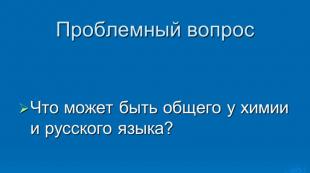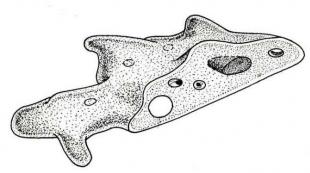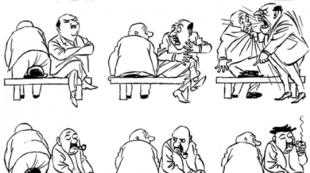Section of the presentation on the theme of Pythagoras. Presentation on the topic: Pythagorean school Here are some of them
Section 2. The use of historical material on the topic "School of Pythagoras" outside school hours.
Form of organization of extracurricular activities -math class.
Forms of presenting historical material:student message, mathematical newspaper, presentation display.
Types of educational activities:
- to acquaint students with historical facts from the life of Pythagoras and his school;
- to acquaint students with what was studied at the school of Pythagoras;
- build skills independent work with a large amount of information;
– learn to present the results of labor using modern information technologies.
Planned educational results:
– acquire knowledge about Pythagoras and his school;
- will acquire knowledge about the merits of Pythagoras to humanity in various fields;
– update knowledge in the field of information and communication technologies, Internet technologies, programming.
- Without knowledge of the past it is impossible to understand the present and
- it is absolutely impossible to imagine the future correctly.
Historical reference.
In the list of the greatest mathematicians of antiquity and our days, Pythagoras should certainly be in the first place. It was he who carried out a radical transformation of mathematics, turning it from a set of useful rules into an abstract deductive science.
Mathematician Proclus, who lived in the V century. AD, wrote: “Pythagoras transformed this science into a form of free education. He studied this science from its first foundations, and tried to obtain theorems using purely logical thinking, beyond concrete ideas.
The most fragmentary information has been preserved about the life of Pythagoras. He was born around 570 AD. e. on the Greek island of Samos (presentation slide No. 1-4).
Being a young man striving for knowledge, Pythagoras left his native island. He visited all the Hellenic and many foreign countries, studied with famous scientists and admired the wonders of the East (presentation slide No. 5-8).
When Pythagoras returned to the island of Samos, Polycrates ruled there. His tyranny was so strong that, as the ancient historian writes, "a free man could not endure arbitrariness and despotism with dignity." Pythagoras moved to Croton, a city in southern Italy. There he founded the famous Pythagorean Union, which set itself not only scientific, but also religious, ethical and political goals. The glory of Pythagoras as an educator is so great that all the young men wanted to become his students, and their fathers preferred that they spend time with him than do own affairs. Plato, in his only mention of Pythagoras, calls him "the leader of the youth", who created a special Pythagorean way of life.
The activities of the union were secret. Access to it was not open to everyone (slide No. 9-17).
It was impossible to share one's discoveries with those who were not members of the union. The Pythagoreans distinguished four areas of science: the doctrine of numbers (arithmetic), figures and measurements (geometry), astronomy and the doctrine of harmony (music theory).
According to Pythagoras, it is the science of numbers that can possess the key of life and the essence of being.Penetrating into the properties of numbers, explaining their various combinations, Pythagoras tried to create the science of all sciences.
The number for the Pythagoreans is the main object of mathematics. They considered it as a collection of units, that is, they studied only positive integers. With their help, the Pythagoreans wanted to explain the whole world surrounding man, the structure of the universe. The statement “everything is a number” belongs to Pythagoras himself, and was the basis of his teaching.
The units that make up positive integers were considered indivisible and were depicted as points. They considered "triangular" numbers
1, 1+2=3, 1+2+3=6, 1+2+3+4=10,…,
1+2+3+…+ n = .
He divided all numbers into two types: even and odd, and with amazing sensitivity revealed the properties of the numbers of each group. Even numbers have the following properties: any number can be divided into two equal parts, both of which are either even or odd. For example, 14 is divided into two equal parts 7 + 7, where both parts are odd; 16 = 8 + 8 where both parts are even. The Pythagoreans considered an even number, the prototype of which was the duad, indefinite and feminine.
Pythagoras divided even numbers into 3 classes: even-even, even-odd, odd-odd. The first class is made up of numbers, which are the doubling of numbers, starting from one. Thus, these are 1,2,4,8,16,32,64,128,512 and 1024. Pythagoras saw the perfection of these numbers in the fact that they can be divided in half and again, and so on until one is obtained. Even-even numbers have some unique properties. The sum of any number of terms1 except the last one is always equal to the last minus one. For example, the sum of four terms (1 + 2 + 4 + 8) is equal to the fifth term - 16 minus one, that is, 15. A series of even-even numbers also has the following property: the first term, multiplied by the last, gives the last term in the row with an odd number of terms will not leave one number, which, when multiplied by itself, will give the last number in the series. Even-odd numbers are numbers that, when divided in half, are not divisible. They are formed as follows: an odd number is taken, multiplied by 2, and so on the whole series of odd numbers. In this process 1,3,5,7,9,11 give even-odd numbers 2,6,10,14,18,22. Thus, each such number is divisible by two once and cannot be divided more. Another feature of this class of numbers is that if the divisor is an odd number, the quotient will always be even, and vice versa. For example, if 22 is divided by 2, an even divisor, the quotient of 11 is odd.
Even numbers are divided into three other classes: superperfect, imperfect and perfect. Superperfect numbers are such numbers, the sum of fractional parts, which are greater than themselves. For example, 24 has the sum of its fractional parts 12+6+4+8+3+2+1 33, which is more than 24, the original number. Pythagoras called imperfect numbers, the sum of fractional parts, which are less than himself. For example, the number 14 is the sum of its fractional parts 7+2+1=10, which is less than 14. A perfect number is a number whose sum of fractional parts is equal to the number itself. Such numbers are extremely rare. There is only one number between 1 and 10, namely 6; one between 10 and 100 - the number 28, one between 100 and 1000 - 496, one between 1000 and 10000 - 8128. Perfect numbers are found as follows: the first number of a series of even-even numbers is added to the second number of the series, and if a prime number is obtained, it is multiplied by the last number of a series of even-even numbers that participated in the formation of the sum. If the addition of even-even numbers does not lead to a non-composite number.
The Pythagoreans developed their philosophy from the science of numbers. Perfect numbers, they believed, are beautiful images of virtues. They represent the middle between excess and disadvantage. They are very rare and are produced in perfect order. In contrast, super-abundant and imperfect numbers, of which there are no matter how many, are not arranged in order and are not generated for some specific purpose. And so they bear a great resemblance to vices, which are numerous, disordered, and indefinite.
The Pythagoreans considered the odd number, whose prototype was the monad, to be definite and masculine, although there was some disagreement among them about 1 (one). It has been considered positive by some because if added to an odd number it becomes even and is thus considered an androgenic number, combining both masculine and feminine attributes, so it is both even and odd.
The Pythagorean custom was to offer an odd number of objects to the higher gods, while to the goddesses and underground spirits to bring an even number.
Odd numbers are divided into 3 general classes: non-composite, composite, and non-composite - composite. Non-composite numbers are numbers that have no other divisors than themselves and one. These are the numbers 3,5,7,11,13,17, etc. Composite numbers are numbers that are divisible not only by themselves, but also by some other numbers. Such numbers are those of the odd numbers that are not included in the group of non-composite. These are the numbers 9,15,21,25,27,33,39, etc. Non-composite-composite numbers - these are numbers that do not have common divisor, although each of them is divisible. If you take two numbers and find that they do not have a common divisor, such numbers can be called non-composite-composite numbers. For example, the numbers 9 and 25. 9 is divisible by 3 and 25 by 5, but neither is divisible by the divisor of the other, they have no common divisor. They are called non-composite-composite because each of them has an individual divisor, and since these numbers do not have a common divisor, they are called non-composite. Thus, non-composite-composite numbers are found only in pairs with each other.
We also considered "square" numbers
1, 1+3=4, 1+ 3 +5 = 9,…,
1 + 3 + 5+ ... + (2n - 1) = n 2 (slide No. 18-26).
Defined by the Pythagoreans and "cubic" numbers
1,8,27,64,…,n 3 .
The main achievement of the Pythagorean school was the construction of the theory of divisibility. They divided all natural numbers into even and odd, prime and composite. They formulated a theorem: the product of two numbers is divisible by 2 if and only if at least one of the factors is divisible by 2. Then any even natural number can be represented as N= 2 k N 1 , where N 1_ - odd, k is a non-negative integer.
The Pythagoreans set the task of finding perfect numbers, that is, those that are equal to the sum of their divisors (excluding the number itself). For example: 6 = 1 + 2 + 3, 28 = 1 +2 + 4 +7 +14 etc.
The unit was considered the mother of all numbers, the number 2 expressed a line, 3 a triangle, 4 a pyramid. These arguments connected arithmetic with geometry. The unit could be interpreted as a point, the number 2 is a line, i.e., a one-dimensional image, the triangle defines a plane, and the number 4 is a three-dimensional image.
The Pythagoreans believed so deeply in the miraculous properties of the number 10 that they invented a new planet and named it Counter-Earth. The fact is that at that time there were 9 celestial spheres (sky, Sun, Moon, Earth, Mercury, Mars, Jupiter, Saturn). They believed that there are 10 more spheres, and the Counter-Earth rotates on it.
They had an "oath number 36". Special properties were attributed to it in connection with the fulfillment of the relations
36 = 1 3 + 2 3 + 3 3 ; 36 = (2 + 4 + 6 +8) + (1 + 3 + 5 + 7).
Exploring the set of natural numbers 1, 2, 3, ..., n, ... the ancient Greeks were the first to realize the idea of the infinity of objects studied by mathematics.
They were able to perform arithmetic operations with rational numbers m/n, where m and n are natural numbers.
The turning point in the development of ancient mathematics was the discovery of incommensurable segments, or, in other words, the discovery of irrational numbers.
Pythagoras proved the theorem
X 2 + Y 2 \u003d Z 2,
where X, Y are the legs of a right triangle, and Z is the hypotenuse (slide No. 27,28).
According to legend, he sacrificed 100 bulls to the gods as a token of gratitude.
Triplets of numbers that satisfy this equation are called - "Pythagorean",
(3, 4, 5), (5, 12, 13), (7, 24, 25), …
X \u003d 1/2 (m 2 - 1), Y \u003d m, Z \u003d 1/2 (m 2 + 1), where m is a natural odd number.
But they only knew rational numbers. The Pythagoreans decided not to tell anyone about their paradoxical results.
According to legend, Hippas divulged the secret and died under mysterious circumstances (it was believed that the gods punished him).
At the school of Pythagoras, they studied not only mathematics (slide No. 29 -31).
Philosophy and politics were given great attention.
At the beginning of the 5th century BC. after an unsuccessful performance in the political arena, the Pythagoreans were expelled from the cities of southern Italy, their union broke up.
The merits of Pythagoras are undoubtedly great and it is simply impossible to underestimate them (slide No. 32-34).Pythagoras lived in Croton for 30 years. During this time, he managed to realize what remained the dream of many initiates: he created, on top of political power, a wise power of higher knowledge, similar to the ancient Egyptian priesthood. The Council of Three Hundred, created and headed by Pythagoras, was the regulator of the political life of Croton and extended its influence to other cities of Greece for a quarter of a century. There is no reliable information about the time and place of the death of Pythagoras himself. The memories of the Great Teacher and his teachings were preserved by those few who managed to escape to Greece. We find it in the Golden Verses by Lysias, in the commentaries of Heraclitus, in passages by Philolaus and Archytas, and also in Plato's Timaeus. Great slender system given to the world Pythagoras has never been forgotten. It became the basis of Plato's metaphysics, was revived in the Alexandrian school, in the works of many later ancient philosophers.
Material prepared: Isaeva E.P., Senina S.U.
Used sources of information:
1. Dorofeev A.V. Pages of history in mathematics lessons. – Lvov, Quantor magazine, 1991.
2. Aleksandrov A.F. Numerological matrix. Secrets of magic numbers and codes. – M.: RIPOL classic, 2008.
3.. Voloshinov A.V. Pythagoras: Union of truth, goodness and beauty. - M.: Enlightenment, 1993.
4. Zhmud L.Ya. Pythagoras and his school, - Science, 1990.
5. Losev A. Myth, number, essence, - M .: 1994.
6. Perepelitsin M.L. Philosopher's Stone, - 1990.
7Asmus VF: Ancient Philosophy, -1971.
8. Shure E. Great Initiates, 1 volume, translation by E. Pisareva. - Kaluga: 1914.
9. Internet resources.
Preview:
https://accounts.google.com
Slides captions:
The Pythagoreans sing the Hymn to the Sun
Mathematicians - "knowing"
Preview:
To use the preview of presentations, create a Google account (account) and sign in: https://accounts.google.com
Slides captions:
Pythagoras and his school. The work was completed by: Isaeva E.P. Senina S. U. Pugachev - 2013
"All things are numbers" Pythagoras
The purpose of the study What is the essence of the teachings of Pythagoras? Who are the Pythagoreans? What is the connection between Pythagoras and the word "cosmos"?
Pythagoras of Samos (c. 580 - c. 500 BC) - ancient Greek philosopher, religious and political figure, founder of Pythagoreanism, mathematician. Pythagoras is credited with studying the properties of integers and proportions, proving the Pythagorean theorem, etc.
Biography of Pythagoras Pythagoras' parents were Mnesarchus and Partenida from Samos. Mnesarchus was a stone cutter; according to Porfiry, he was a rich merchant from Tyre, who received Samian citizenship for the distribution of grain in a lean year. Partenida, later renamed Pythaida by her husband, came from the noble family of Ankey, the founder of the Greek colony on Samos. The birth of a child was allegedly predicted by the Pythia in Delphi, therefore Pythagoras got his name, which means "the one whom the Pythia announced."
Years of study Iamblichus writes that Pythagoras left his native island at the age of 18 and, having traveled around the wise men in different parts of the world, reached Egypt, where he stayed for 22 years, until he was taken to Babylon among the captives by the Persian king Cambyses, who conquered Egypt in 525 BC e. Pythagoras stayed in Babylon for another 12 years, communicating with magicians, until he was finally able to return to Samos at the age of 56, where his compatriots recognized him as a wise man.
School of Pythagoras The school was founded by Pythagoras and existed until the beginning of the 4th century. BC, although the persecution of her began almost immediately after the death of Pythagoras in 500.
The Pythagoreans sing the Hymn to the Sun
The first stage Pythagoras usually sent the candidate back, advising him to wait and come back in three years. This outwardly very severe reception was filled with deep meaning - after all, any impulse, even the most beautiful and pure, must pass the test of time.
The second stage During this period, a person was not yet considered a student of the School and was called an acusmatik (“listener”). He listened, absorbed, realized - and all this happened in silence. Pythagoras "prescribed a five-year silence to acousticians, testing their ability to refrain, since silence is the most difficult kind of abstinence."
The third stage Only after many years of such work did the acusmatist become a real Pythagorean student. Now he bore the title of mathematician - "cognizing". In the classes conducted by Pythagoras himself or his closest students, mathematicians were given a complete picture of the world, the structure of Nature and man was revealed. The training of mathematicians took place over a long period of time, but it was also only a preparation.
Mathematicians - "knowing"
The Fourth Stage To devote oneself to serving the people, society, all who need help and protection is a natural step for a mature philosopher. And when the students of mathematics were ready for this, there was a choice of those directions and forms in which this service would be carried out, and then the final training of the chosen “specialty”. Some studied economics, others studied medicine, and so on.
Fifth stage The highest stage in the Pythagorean school was considered the training of politicians - people capable of managing society. The task is to lead people on the basis of the common good, not following the lead of either one's own or other people's interests. Later, Plato revised and expanded the Pythagorean theory of the state - "Plato's ideal state model." Many students of Pythagoras became famous as legislators and fair keepers of laws. The years when the Pythagoreans participated in state affairs were prosperous,
Even-odd The Pythagoreans divided all numbers into two categories - even and odd. Later it turned out that the Pythagorean "even - odd", "right - left" have deep and interesting consequences in quartz crystals, in the structure of viruses and DNA, in the famous experiments of Pasteur, in parity violation of elementary particles and other theories.
Even... Odd... The Pythagoreans considered even numbers to be feminine and odd numbers to be masculine. Marriage is a five equal to three plus two. For the same reason, a right-angled triangle with sides three, four, five was called by them "the figure of the bride."
Tetrad Numbers 1, 2, 3 and 4 made up the famous "tetrad". Geometrically, the tetrad was depicted as a "perfect triangle", arithmetically - as a "triangular number" 1 + 2 + 3 + 4 \u003d 10. The Pythagoreans swore "by those who put the tetrad into our soul, the source and root of eternal nature" .
The ideal number The sum of the numbers included in the tetrad is equal to ten, which is why the Pythagoreans considered ten to be the ideal number and symbolized the Universe. Since the number ten is ideal, they reasoned, there should be exactly ten planets in the sky. It should be noted that at that time only the Sun, Earth and five planets were known. They named the tenth planet Counter-Earth.
Ten Ten can be expressed as the sum of the first four numbers (1+2+3+4=10), where one is the expression of a point, two is the expression of a line and a one-dimensional image, three is a plane and a two-dimensional image, four is a pyramid, that is, a three-dimensional image. Why not the four-dimensional universe of Einstein?
Justice and Equality The Pythagoreans saw justice and equality in the square of a number. Their symbol of constancy was the number nine, since all multiples of nine numbers have the sum of the digits, again nine. 9*2=18 1+8=9; 7*9=63 6+3=9; 11*9=99 9+9=18 1+8=9; 25*9= 225 2+2+5=9.
The number eight among the Pythagoreans symbolized death, since multiples of eight have a decreasing sum of digits. 8*2=16 1+6=7; 8*3=24 2+4=6; 8*4=32 3+2=5; 8*5+40 4+0=4; 8*6=48 4+8=12 1+2=3
"Bad numbers" In addition to the numbers that caused admiration and admiration, the Pythagoreans also had the so-called bad numbers. These are numbers that did not have any merit, and even worse if such a number was surrounded by "good" numbers. The famous number thirteen is the devil's dozen The number seventeen, which caused particular disgust among the Pythagoreans.
More about numbers The Pythagoreans had an "oath by the number 36". Special properties were attributed to him 36=(2+4+6+8)+(1+3+5+ 7)
"COSMOS" Pythagoras introduced this word into science, understanding by it something harmonious and whole, obeying the laws of harmony and numbers.
WHAT IS WORLD? “The world is a limited sphere, rushing in infinity… The movement of heavenly bodies is the harmony of singing cosmic spheres, inaudible to us…”
The merits of Pythagoras are undoubtedly great and it is simply impossible to underestimate them. Pythagoras lived in Croton for 30 years. During this time, he managed to realize what remained the dream of many initiates: he created, on top of political power, a wise power of higher knowledge, similar to the ancient Egyptian priesthood. The Council of Three Hundred, created and headed by Pythagoras, was the regulator of the political life of Croton and extended its influence to other cities of Greece for a quarter of a century. The beautiful harmonious system given to the world by Pythagoras was never forgotten. It became the basis of Plato's metaphysics, was revived in the Alexandrian school, in the works of many later ancient philosophers.
Information sources. Aleksandrov A.F. Numerological matrix. Secrets of magic numbers and codes. - M.: RIPOL classic, 2008. 2. Dorofeeva A.V. Pages of history in mathematics lessons. Lvov, 1991. 3. 3. Voloshinov A.V. Pythagoras: Union of truth, goodness and beauty. - M.: Enlightenment, 1993. 4. Zhmud L.Ya. Pythagoras and his school, - Science, 1990. 5. Losev A. Myth, number, essence, - M .: 1994. 6. Perepelitsin M.L. Philosopher's Stone, - 1990. 7Asmus V.F: Ancient Philosophy, -1971. 8. Shure E. Great Initiates, 1 volume, translation by E. Pisareva. - Kaluga: 1914. 9. Internet resources.
1 slide

2 slide
Biography: Pythagoras of Samos (ancient Greek Πυθαγόρας ὁ Σάμιος, lat. Pythagoras; 570-490 BC) was an ancient Greek philosopher, mathematician and mystic, creator of the religious and philosophical school of the Pythagoreans.

3 slide
The parents of Pythagoras were Mnesarchus and Partenida from the island of Samos. The birth of a child was allegedly predicted by the Pythia in Delphi, therefore Pythagoras got his name, which means "the one whom the Pythia announced." At a young age, Pythagoras went to Egypt to gain wisdom and secret knowledge from the Egyptian priests.

4 slide
The disciples of Pythagoras formed a kind of religious order, or a brotherhood of initiates, consisting of a caste of selected like-minded people who literally deify their teacher, the founder of the order. This order actually came to power in Croton, however, due to anti-Pythagorean sentiments at the end of the 6th century. BC e. Pythagoras had to retire to another Greek colony, Metapont, where he died.

5 slide
Pythagoras had a wife named Theano, a son Telavg and a daughter Mnia (according to another version, the son of Arimnest and the daughter of Arignot) Pythagoras died peacefully at the age of 80, or at 90 years old (according to unnamed other sources). From this follows the date of death 490 BC. e. (or 480 BC, which is unlikely). Eusebius of Caesarea in his chronography indicated 497 BC. e. as the year of the death of Pythagoras.

6 slide
Philosophical doctrine The doctrine of Pythagoras should be divided into two components: a scientific approach to understanding the world; a religious and mystical way of life. According to Pythagoras, eternal soul migrates from heaven into the mortal body of a person or animal and undergoes a series of transmigrations until he earns the right to return back to heaven. Despite the common opinion that Pythagoras was allegedly a vegetarian, Diogenes Laersky writes that Pythagoras occasionally ate fish, abstained only from arable bulls and rams, and allowed other animals for food. Pythagoras in a fresco by Raphael (1509)

7 slide
Scientific achievements modern world Pythagoras is considered the great mathematician and cosmologist of antiquity, but early evidence before the 3rd century. BC e. no mention of his merits. As Iamblichus writes about the Pythagoreans: “They also had a wonderful custom of attributing everything to Pythagoras and not at all appropriated the glory of the discoverers, except perhaps in a few cases.” Coin with the image of Pythagoras

8 slide
The ancient authors of our era give Pythagoras the authorship of the well-known theorem: the square of the hypotenuse of a right triangle is equal to the sum of the squares of the legs. This opinion is based on the information of Apollodorus the Calculator (the person is not identified) and on poetic lines (the source of the verses is unknown): “On the day when Pythagoras opened his famous drawing, he erected a glorious sacrifice for him with bulls.”

9 slide
Modern historians suggest that Pythagoras did not prove the theorem, but could pass this knowledge to the Greeks] known in Babylon 1000 years before Pythagoras (according to the Babylonian clay tablets with records of mathematical equations). Although there is doubt about the authorship of Pythagoras, there are no weighty arguments to challenge this.

10 slide
Pythagoras is one of the most interesting and mysterious personalities in history Pythagoras founded a religion whose main provisions were the doctrine of the transmigration of souls and the sinfulness of eating beans. Here are some prescriptions of the Pythagorean order:

11 slide
1. Refrain from eating beans. 2. Do not pick up what has fallen. 3. Don't touch the white rooster. 4. Don't break bread. 5. Don't step over the bar. 6. Do not stir fire with iron. 7. Don't take a bite out of a whole bun. 8. Don't pluck the wreath. 9. Don't sit on a one-quart measure. 10. Do not eat hearts. 11. Don't walk on high road. 12. Do not let swallows live under the roof. 13. When taking the pot out of the fire, do not leave a trace of it on the ashes, but stir the ashes. 14. Do not look in the mirror near the fire. 15. When you get out of bed, roll up the bed linen and smooth out the traces of your body left on it.

12 slide
The fate of Pythagoras himself and his union had a sad end, but Pythagorism with its metaphysics, scientific knowledge, and views on education continued to influence further development science and philosophy. Undoubtedly, the school of Pythagoras played a great role in improving the scientific methods of solving mathematical problems: the position on the need for rigorous proofs entered the mathematics of the firmament, which gave it the importance of a special science. A crater on the visible side of the Moon is named after Pythagoras.
He owns geometric discoveries, such as the well-known theorem Pythagoras about the ratio of the hypotenuse and the legs of a right triangle, the doctrine of ... the idea of \u200b\u200bthe cosmos in today's sense belongs to the Pythagoreans. Pythagoras first used the word cosmos in its current sense for ...
A conspiracy is brewing, orders his men to watch Pythagoras. Outraged Pythagoras leaves the island forever and settles in one of ... memories of "Pythagorean pants". The reason for the popularity of the theorem Pythagoras due to its simplicity, beauty, significance. The study of Babylonian, ancient Chinese...

Antiquities do not confirm this. Perhaps the most famous achievement Pythagoras- a theorem according to which the square of the hypotenuse of a right triangle ... 367 proofs of this theorem were recorded. Probably the theorem Pythagoras is the only theorem with such an impressive number of proofs...

The sea off the coast of Asia Minor, therefore it is called Pythagoras Samos. Was born Pythagoras in the family of a stone carver, who soon found ... he was allowed to get acquainted with the centuries-old achievements of Egyptian science. When Pythagoras comprehended the science of the Egyptian priests, then he was going home to ...

Pythagoras and his teaching presentation - Mo...
What is the essence of teaching Pythagoras? Who are the Pythagoreans? What is the connection between Pythagoras and the word "space"? LIFE PYTHAGORE Pythagoras was born on the island of Samos... and appeared in the Greek city of Crotone in southern Italy. SCHOOL PYTHAGORE Pythagoras and his followers, the Pythagoreans, formed a secret alliance. To...

Society. The school caused displeasure of the democratic authorities of the island, and PYTHAGORAS I had to leave my homeland. PYTHAGOREAN UNION In 531 BC, which gave it the significance of a special science. THEOREM PYTHAGORE With name PYTHAGORE the famous theorem is related (the square of the length of the hypotenuse is equal to the sum ...
PYTHAGORAS SAMOS
He was born in 5 80 BC



The mother of Pythagoras - Parthenis - after the birth of her son, according to ancient tradition, takes the name Pythiades, in honor of the Pythian Apollo, and calls her son Pythagoras, that is, predicted by Pythia -
Delphic soothsayer.











Returning to the island of Samos, he
founded a philosophical school, where, in addition to philosophy, they studied religion, mathematics, arithmetic and geometry

artist F. Bronnikov(1827-1902) painted a picture "Pythagorean hymn to the rising sun"

GOLDEN POEMS" PYTHAGORAS
However, there have been changes in Greece. The best minds, fleeing the Persian yoke, moved to southern Italy and founded colonial cities: Syracuse, Agrigent, Croton.
Pythagoras settled in Croton. The inhabitants of Croton unanimously elect the wise old man as the censor of morals, a kind of spiritual father of the city.

Here are some of them:
Flee from every trick; cut off disease from the body with fire, iron, and your favorite weapon, ignorance from the soul, luxury from the womb, trouble from the city, quarrel from the family.

The day of the Pythagorean was to end with verses:
Do not allow lazy sleep on tired eyes before you answer three questions about the business of the day:
"What I've done? What didn't he do? And what is left for me to do? - and start the day with verses: “Before you get up from the sweet dreams cast by the night, spread your soul what things the day has prepared for you”

- proved the theorem that now bears his name;
- introduced proof into geometry;
- laid the foundations of the theory of proportions (arithmetic, geometric and harmonic);
- developed the theory of music and acoustics;
- made a guess about the sphericity of the Earth;

Divine Numbers
At the heart of the religious and philosophical teachings of Pythagoras was the idea of number as the basis of everything that exists in the world. The most important achievement of the Pythagoreans was their discovery of perfect numbers. A natural number equal to the sum of all its divisors: 6=1+2+3; 28=1+2+4+7+14.

Simple numbers.
1 - the number of energy, action, reason (because it is at the beginning), achievement of the goal (in one's own interests).
2 - the number of opposites, polarities, such as day and night, good and evil, boy and girl ... Depending on the situation, opposites can conflict - argue and compete, or complement each other, maintaining a state of balance.

3 - was presented as a number that unites the past, present and future. People who know how to arrange their present, foreseeing the future and using the experience of the past, are wise, and therefore the Pythagoreans associated the three with wisdom. At the same time, this is the number of knowledge, since music, mathematics and astronomy - the "three pillars" of knowledge of the world - just formed a triad. In addition, three is the number of balance, peace and friendship.

4 - four cardinal points, four seasons, four elements - fire, earth, water and air, that is, the basis of everything. That which is reliable was, is and will always be. For this, the Pythagoreans highly respected the four. But their followers, agreeing with the idea of the stability of the four (the square is the most stable geometric figure), came to the conclusion that this number is "without flight", since it is too connected with earthly affairs. Subsequently, the cross (having four sides) became a symbol of the Earth and everything material, that is, that which can be touched, smelled and tasted.


6 is the number the Pythagoreans called "perfection" and "harmony". It is also associated with health and balance (because it consists of two triplets).
7 - seven colors of the rainbow, seven notes of the scale, seven planets known to the ancient Greeks are associated with this number - that is, extraordinary phenomena, 7 - the number of chance, good luck and revelation from above.


9 - the number of a person with all his shortcomings, since before the perfect number of Pythagoreans, 10, nine lacks one. Nine was a symbol of lawlessness, since there is nothing behind it except the infinite number 10. Subsequently, interpreters of numbers began to explain nine as the number of success on the grounds that this is the largest of prime numbers.
The science of the secret meaning of numbers became known as numerology.

Pythagorean triplets
An arithmetic problem is associated with the Pythagorean theorem: there are such triples of natural numbers x, y, z that x 2 + y 2 \u003d z 2. Today this problem is called the Pythagorean problem, and its solution - triples of natural numbers - Pythagorean triples. Particular solutions were known in ancient times: in Ancient Egypt, for example, a triangle with sides 3, 4, 5 was used when marking rectangular land plots after the annual destruction of their borders by the flooded Nile.

Is it possible to find all solutions of the equation
x 2 + y 2 \u003d z 2 in natural numbers? Looking for an answer to this question, Pythagoras found formulas that in modern symbolism can be written as follows: a \u003d 2n + 1, b \u003d 2n (n + 1), c \u003d 2n 2 + 2n + 1, where n is any natural number.
For different values of n, one can obtain all possible sets of Pythagorean triples:
n = 1, (3, 4, 5); n = 2, (5, 12, 13); n = 3, (7, 24, 25).

Pythagorean theorem
In the Russian translation of the Euclidean "Beginnings", the Pythagorean theorem is stated as follows:
"In a right triangle, the square of the side opposite the right angle is equal to the sum of the squares of the sides containing the right angle."



This proof is obtained in the simplest case of an isosceles right triangle. Probably, the theorem began with him. Indeed, it is enough just to look at the tiling of isosceles right triangles to see that the theorem is true.
For example, for the triangle ABC: the square built on the hypotenuse AC contains 4 initial
triangles and squares built
on the legs, - two. The theorem has been proven.

Practical use pythagorean theorems
1. The Pythagorean theorem is used to calculate the lengths of segments of some figures on the plane and in space;
2. in construction and architecture;
4.The Pythagorean theorem and mobile communication

Currently, there is a lot of competition among operators in the mobile communication market. The more reliable the connection, the larger the coverage area, the more consumers the operator has. When building a tower (antenna), it is often necessary to solve the problem: what is the highest height the antenna should have so that the transmission can be received within a certain radius (for example, radius R \u003d 200 km ?, if it is known that the radius of the Earth is 6380 km.)
Using the Pythagorean theorem, we get the answer.
Answer: 2.3 km.

Thoughts and aphorisms of Pythagoras
In the field of life, like a sower, walk with even and steady steps.
The true fatherland is where there are good morals.
Do not be a member of a learned society: the wisest, making up a society, become commoners.
Revere sacred numbers, weight and measure, as a child of graceful equality.
Measure your desires, weigh your thoughts, number your words.
Be astonished at nothing: astonishment has produced gods.
If they ask what is older than the gods? - answer: fear and hope.

"Do not chase after happiness: it is always in yourself."
slide 1
slide 2
 Pythagoras of Samos (c. 580 - c. 500 BC) - ancient Greek philosopher, religious and political figure, founder of Pythagoreanism, mathematician. Pythagoras is credited with studying the properties of integers and proportions, proving the Pythagorean theorem, etc.
Pythagoras of Samos (c. 580 - c. 500 BC) - ancient Greek philosopher, religious and political figure, founder of Pythagoreanism, mathematician. Pythagoras is credited with studying the properties of integers and proportions, proving the Pythagorean theorem, etc.
slide 3
 School of Pythagoras The school was founded by Pythagoras and existed until the beginning of the 4th century. BC, although the persecution of her began almost immediately after the death of Pythagoras in 500. Admission to the school took place in several stages
School of Pythagoras The school was founded by Pythagoras and existed until the beginning of the 4th century. BC, although the persecution of her began almost immediately after the death of Pythagoras in 500. Admission to the school took place in several stages
slide 4
 The first stage Pythagoras usually sent the candidate back, advising him to wait and come back in three years. This outwardly very severe reception was filled with deep meaning - after all, any impulse, even the most beautiful and pure, must pass the test of time.
The first stage Pythagoras usually sent the candidate back, advising him to wait and come back in three years. This outwardly very severe reception was filled with deep meaning - after all, any impulse, even the most beautiful and pure, must pass the test of time.
slide 5
 The second stage During this period, a person was not yet considered a student of the School and was called an acusmatik (“listener”). He listened, absorbed, realized - and all this happened in silence. Pythagoras "prescribed a five-year silence to acousticians, testing their ability to refrain, since silence is the most difficult kind of abstinence."
The second stage During this period, a person was not yet considered a student of the School and was called an acusmatik (“listener”). He listened, absorbed, realized - and all this happened in silence. Pythagoras "prescribed a five-year silence to acousticians, testing their ability to refrain, since silence is the most difficult kind of abstinence."
slide 6
 The third stage Only after many years of such work did the acusmatist become a real Pythagorean student. Now he bore the title of mathematician - "cognizing". In the classes conducted by Pythagoras himself or his closest students, mathematicians were given a complete picture of the world, the structure of Nature and man was revealed. The training of mathematicians took place over a long period of time, but it was also only a preparation.
The third stage Only after many years of such work did the acusmatist become a real Pythagorean student. Now he bore the title of mathematician - "cognizing". In the classes conducted by Pythagoras himself or his closest students, mathematicians were given a complete picture of the world, the structure of Nature and man was revealed. The training of mathematicians took place over a long period of time, but it was also only a preparation.
Slide 7
 The Fourth Stage To devote oneself to serving the people, society, all who need help and protection is a natural step for a mature philosopher. And when the students of mathematics were ready for this, there was a choice of those directions and forms in which this service would be carried out, and then the final training of the chosen “specialty”. Some studied economics, others studied medicine, and so on.
The Fourth Stage To devote oneself to serving the people, society, all who need help and protection is a natural step for a mature philosopher. And when the students of mathematics were ready for this, there was a choice of those directions and forms in which this service would be carried out, and then the final training of the chosen “specialty”. Some studied economics, others studied medicine, and so on.
Slide 8
 Fifth stage The highest stage in the Pythagorean school was considered the training of politicians - people capable of managing society. The task is to lead people on the basis of the common good, not following the lead of either one's own or other people's interests. Later, Plato revised and expanded the Pythagorean theory of the state - "Plato's ideal state model." Many students of Pythagoras became famous as legislators and fair keepers of laws. The years when the Pythagoreans participated in state affairs were prosperous,
Fifth stage The highest stage in the Pythagorean school was considered the training of politicians - people capable of managing society. The task is to lead people on the basis of the common good, not following the lead of either one's own or other people's interests. Later, Plato revised and expanded the Pythagorean theory of the state - "Plato's ideal state model." Many students of Pythagoras became famous as legislators and fair keepers of laws. The years when the Pythagoreans participated in state affairs were prosperous,
slide 9
 Aphorisms of Pythagoras Do not do anything shameful either in the presence of others or in secret. Your first law should be respect for yourself. In order to understand the manners of any people, try first to learn their language. If you can be an eagle, do not strive to be the first among the jackdaws. During anger one should neither speak nor act. Life is like a game: some come to compete, others to trade, and the happiest to watch. However short the words "yes" and "no" may be, they still require the most serious reflection.
Aphorisms of Pythagoras Do not do anything shameful either in the presence of others or in secret. Your first law should be respect for yourself. In order to understand the manners of any people, try first to learn their language. If you can be an eagle, do not strive to be the first among the jackdaws. During anger one should neither speak nor act. Life is like a game: some come to compete, others to trade, and the happiest to watch. However short the words "yes" and "no" may be, they still require the most serious reflection.
slide 10
 Wash the offense you have received not in blood, but in Lethe, the river of oblivion. Drunkenness is an exercise in madness. Ask a drunkard how he could stop drinking. I will answer for him: let him often remember the things he does while drunk. Friends have everything in common, and friendship is equality.
Wash the offense you have received not in blood, but in Lethe, the river of oblivion. Drunkenness is an exercise in madness. Ask a drunkard how he could stop drinking. I will answer for him: let him often remember the things he does while drunk. Friends have everything in common, and friendship is equality.
slide 11
 The great science of living happily consists in living only in the present. What is the most reasonable of all? Time is the smartest of all. Keeps the past, and the future - the seed. What is the most essential? - Hope light. It exists where there is nothing else. Do not judge your greatness by your shadow at sunset.
The great science of living happily consists in living only in the present. What is the most reasonable of all? Time is the smartest of all. Keeps the past, and the future - the seed. What is the most essential? - Hope light. It exists where there is nothing else. Do not judge your greatness by your shadow at sunset.
slide 12
 Even-odd The Pythagoreans divided all numbers into two categories - even and odd. Later it turned out that the Pythagorean "even - odd", "right - left" have deep and interesting consequences in quartz crystals, in the structure of viruses and DNA, in the famous experiments of Pasteur, in parity violation of elementary particles and other theories.
Even-odd The Pythagoreans divided all numbers into two categories - even and odd. Later it turned out that the Pythagorean "even - odd", "right - left" have deep and interesting consequences in quartz crystals, in the structure of viruses and DNA, in the famous experiments of Pasteur, in parity violation of elementary particles and other theories.
slide 13
 Even... Odd... The Pythagoreans considered even numbers to be feminine and odd numbers to be masculine. Marriage is a five equal to three plus two. For the same reason, a right-angled triangle with sides three, four, five was called by them "the figure of the bride."
Even... Odd... The Pythagoreans considered even numbers to be feminine and odd numbers to be masculine. Marriage is a five equal to three plus two. For the same reason, a right-angled triangle with sides three, four, five was called by them "the figure of the bride."
slide 14
 Ten Ten can be expressed as the sum of the first four numbers (1+2+3+4=10), where one is the expression of a point, two is the expression of a line and a one-dimensional image, three is a plane and a two-dimensional image, four is a pyramid, that is, a three-dimensional image. Why not the four-dimensional universe of Einstein?
Ten Ten can be expressed as the sum of the first four numbers (1+2+3+4=10), where one is the expression of a point, two is the expression of a line and a one-dimensional image, three is a plane and a two-dimensional image, four is a pyramid, that is, a three-dimensional image. Why not the four-dimensional universe of Einstein?
slide 15
 Tetrad Numbers 1, 2, 3 and 4 made up the famous "tetrad". Geometrically, the tetrad was depicted as a "perfect triangle", arithmetically - as a "triangular number" 1 + 2 + 3 + 4 = 10. The Pythagoreans swore "by those who put the tetrad into our soul, the source and root of eternal nature."
Tetrad Numbers 1, 2, 3 and 4 made up the famous "tetrad". Geometrically, the tetrad was depicted as a "perfect triangle", arithmetically - as a "triangular number" 1 + 2 + 3 + 4 = 10. The Pythagoreans swore "by those who put the tetrad into our soul, the source and root of eternal nature."
slide 16
 The ideal number The sum of the numbers included in the tetrad is equal to ten, which is why the Pythagoreans considered ten to be the ideal number and symbolized the Universe. Since the number ten is ideal, they reasoned, there should be exactly ten planets in the sky. It should be noted that at that time only the Sun, Earth and five planets were known.
The ideal number The sum of the numbers included in the tetrad is equal to ten, which is why the Pythagoreans considered ten to be the ideal number and symbolized the Universe. Since the number ten is ideal, they reasoned, there should be exactly ten planets in the sky. It should be noted that at that time only the Sun, Earth and five planets were known.
slide 17
 Justice and Equality The Pythagoreans saw justice and equality in the square of a number. Their symbol of constancy was the number nine, since all multiples of nine numbers have the sum of the digits, again nine. 9*2=18 1+8=9; 7*9=63 6+3=9; 11*9=99 9+9=18 1+8=9; 25*9= 225 2+2+5=9.
Justice and Equality The Pythagoreans saw justice and equality in the square of a number. Their symbol of constancy was the number nine, since all multiples of nine numbers have the sum of the digits, again nine. 9*2=18 1+8=9; 7*9=63 6+3=9; 11*9=99 9+9=18 1+8=9; 25*9= 225 2+2+5=9.
slide 18
 The number eight among the Pythagoreans symbolized death, since multiples of eight have a decreasing sum of digits. 8*2=16 1+6=7; 8*3=24 2+4=6; 8*4=32 3+2=5; 8*5+40 4+0=4; 8*6=48 4+8=12 1+2=3
The number eight among the Pythagoreans symbolized death, since multiples of eight have a decreasing sum of digits. 8*2=16 1+6=7; 8*3=24 2+4=6; 8*4=32 3+2=5; 8*5+40 4+0=4; 8*6=48 4+8=12 1+2=3
slide 19
 "Bad numbers" In addition to the numbers that caused admiration and admiration, the Pythagoreans also had the so-called bad numbers. These are numbers that did not have any merit, and even worse if such a number was surrounded by "good" numbers. The famous number thirteen is the devil's dozen The number seventeen, which caused particular disgust among the Pythagoreans.
"Bad numbers" In addition to the numbers that caused admiration and admiration, the Pythagoreans also had the so-called bad numbers. These are numbers that did not have any merit, and even worse if such a number was surrounded by "good" numbers. The famous number thirteen is the devil's dozen The number seventeen, which caused particular disgust among the Pythagoreans.
slide 20
 The number of the beast The very concept of the “number of the beast” first appears in the Revelations of John the Theologian, which appeared for the first time probably in the 1st century AD. Interestingly, the problem has been known for a long time - already in the 2nd century, Bishop Irenaeus claimed that 616 is false, and the true number of the beast is 666. What is the meaning of the “number of the beast”? It is believed that this is the encrypted name of the persecutor of Christians - Emperor Nero. The Hebrew spelling “Neron Kaisar” adds up to just 666, but the Latin “Nero Caesar” just gives 616. This is a palindrome This is a Smith number, that is, the sum of its digits is equal to the sum of the digits of its prime factors 666 is the sum of the squares of the first seven prime numbers In China, the number 6 is, on the contrary, lucky, and on 06/06/06 a record number of marriages were concluded there.
The number of the beast The very concept of the “number of the beast” first appears in the Revelations of John the Theologian, which appeared for the first time probably in the 1st century AD. Interestingly, the problem has been known for a long time - already in the 2nd century, Bishop Irenaeus claimed that 616 is false, and the true number of the beast is 666. What is the meaning of the “number of the beast”? It is believed that this is the encrypted name of the persecutor of Christians - Emperor Nero. The Hebrew spelling “Neron Kaisar” adds up to just 666, but the Latin “Nero Caesar” just gives 616. This is a palindrome This is a Smith number, that is, the sum of its digits is equal to the sum of the digits of its prime factors 666 is the sum of the squares of the first seven prime numbers In China, the number 6 is, on the contrary, lucky, and on 06/06/06 a record number of marriages were concluded there.
slide 21










